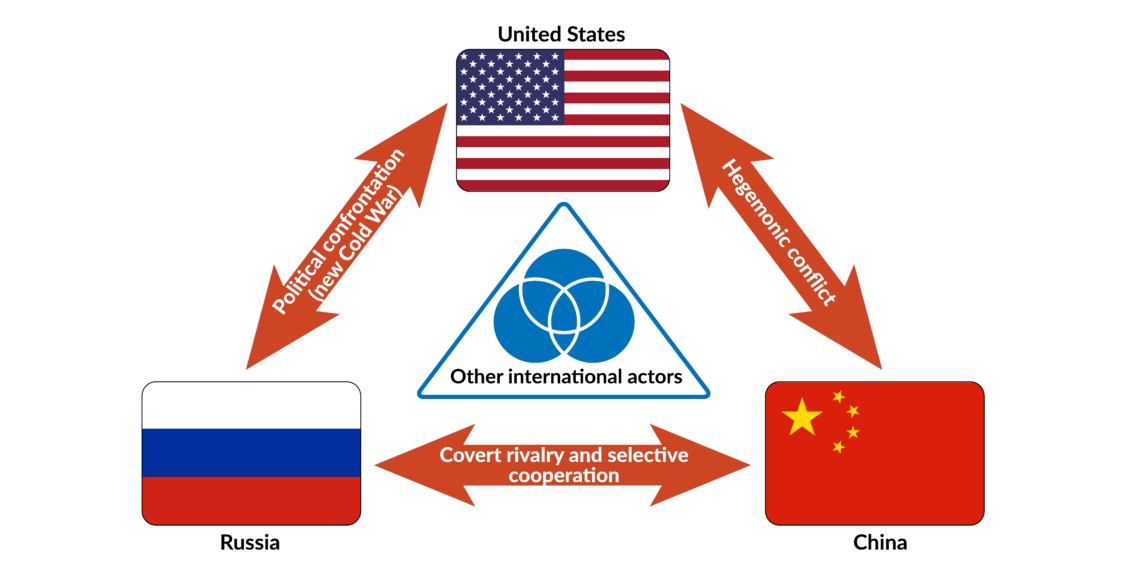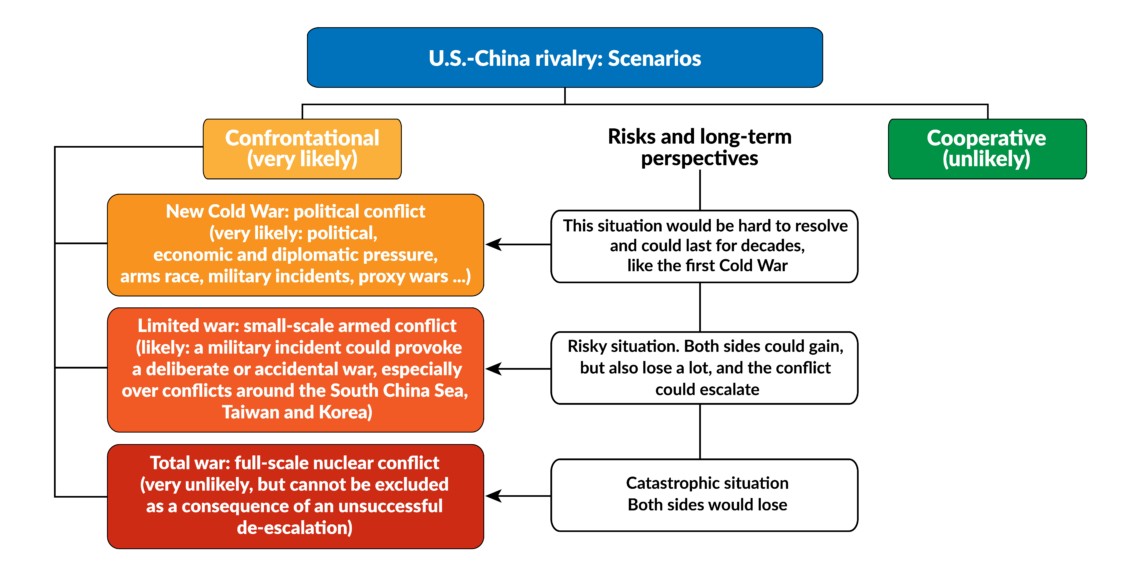The U.S. and China: The rivalry escalates
The “Thucydides trap” posits that when one global power is set to supersede another, war is inevitable. While China is gradually catching up with the U.S. in their global rivalry, an all-out war is unlikely.

In a nutshell
- The U.S. still has the advantage, but China is gaining ground
- Rivalry will become increasingly confrontational
- A full-scale nuclear conflict is unlikely but cannot be excluded
There are three axes in the great power competition of the 21st century: one Euroatlantic between the United States and Russia, one in the Asia-Pacific between the U.S. and China, and finally one in Eurasia between Russia and China.
We can already see that this new order is shifting sharply from the Euroatlantic area to the Asia-Pacific. In the 20th century, the Atlantic axis was at the heart of the world’s security system. Now, relations between the U.S. and China are becoming the dominant factor in international relations.
This is mainly because this competition is taking place between the undisputed global hegemon (the U.S.), and a rapidly developing emerging power aspiring to become a world leader (China). It is no wonder, then, that security analysts are now focused on Asia, where the heated dispute between the two powers is intensifying. It is already a classic hegemonic battle for regional and global dominance, with all its risks for the world. Political scientist Graham T. Allison coined the expression “Thucydides trap” to describe such situations.
Will today’s global power and its rival fall into the trap of a hegemonic war?
In the 5th century BCE, the Greek historian Thucydides described the rivalry between the dominant power – Sparta – and the rising contender – Athens – in the Hellenic world. According to him, it was primarily the former’s fear of losing its position to the latter that led to the outbreak of a long and devastating war for all of Greece. Will today’s global power and its rival also fall, like their ancient predecessors, into the trap of a hegemonic war, and will there be an armed clash between them?
The prevailing opinion is that direct, full-scale war between them is much less likely than between Sparta and Athens in the 5th century. Today’s rivals are nuclear powers and both are fully aware of the threat of mutual annihilation.With this in mind, what could a hegemonic rivalry look like in the 21st century? Let’s look at the interests and potential of both powers.
Comparing strengths
The U.S. became the global hegemon in the 20th century, while China is on its way to achieving the same in the 21st century. It is in Washington’s interest to maintain a strategic position as a world leader in almost all areas: political, economic and military. This dominance, however, is beginning to shrink, largely as a result of China’s economic expansion, but also due to recent American policy.
China, after decades of absence on the world stage, is now active on other continents, including Africa, South America and Europe. In economic terms, it is catching up with the U.S. and will possibly overtake it. Paradoxically, the coronavirus pandemic gives Beijing another advantage because China has actively sought to help other countries, unlike the U.S. This situation reflects a gradual American withdrawal just as the Chinese role on the world stage is expanding.
The U.S. still spends three times more than China on its army, and experts estimate its advantage in all types of military force, including nuclear weapons, is roughly twentyfold. China is a defensive continental military power, unlike the U.S., which is an expansive air and sea power. Confrontation between them is therefore more likely to take place in China’s strategic environment.
China has recently invested heavily in the development of its navy to at least partially balance the U.S.’s advantage at sea and to gain the military capabilities necessary to become a global power. Washington, in turn, wants to strengthen its capacity for regional pressure by weakening Beijing’s continental strategic strength, which lies mainly in its anti-access capabilities. To achieve this, the Trump administration has withdrawn from the Intermediate-Range Nuclear Forces Treaty (INF Treaty), which will allow the U.S. to deploy missiles in China’s vicinity.
China has recently invested heavily in the development of its navy.
There has been an attempt to engage China in U.S.-Russian negotiations through the new Strategic Arms Reduction Treaty (New START). While it would undoubtedly be desirable for Beijing to participate, it is also very improbable. China would have to obtain other strategic guarantees in exchange, like the withdrawal of U.S. troops from South Korea or an end to American support for Taiwan – concessions the White House is unlikely to make.
Space and cybersecurity are becoming important areas of military rivalry. China has recently made great progress, seriously challenging the U.S. on those fronts. Chinese activities are the main driving force behind the computerization of American armed forces, and industrial advances like 5G technology also pose a threat. The result of this competition will largely determine the military relationship between them in the future.
Scenario
Two broad scenarios could unfold: cooperative and confrontational. In a confrontational setting, there are three possible outcomes – a cold war without direct military confrontation, a limited war with only small-scale military clashes, and a total war with full-scale conflict, including nuclear weapons.
The cooperative option is very unlikely. Although it cannot be completely ruled out, it is mostly realistic only after a phase of sharp confrontation, with an event showcasing the lethal risks of war. A previous example is the Cuban Missile Crisis of 1962, which brought the U.S. and the Soviet Union to the brink of mutual nuclear annihilation and led to an era of relaxation.
In a 21st-century U.S.-China confrontation, this type of clash could arise if a conventional conflict escalates and a nuclear intervention is stopped at the last minute. It could also occur if both powers implement a new and dangerous type of cyber weapon.Therefore, without completely rejecting the unlikely cooperative scenario, it is worth paying much closer attention to a possible confrontation.
Facts & figures

It could be that the U.S.-China rivalry will unfold in a manner entirely similar to the ongoing Euroatlantic tension between Russia and the West. The situation would fall under what is known as “political warfare” – a confrontation using both soft and hard political tools, but still falling below the threshold of a direct armed conflict.
This new cold war has already begun. Recently, it has been particularly evident in the realm of trade, cyber espionage, diplomatic pressure and military tension, especially over incidents in the South China Sea. This form of competition is difficult to resolve and could last for decades, much like with the Soviet Union.
As time passes, the arms race will escalate. The two powers will compete in the realm of space exploration and cybersecurity. Proxy wars associated with Chinese expansion, in addition to political blackmail, could also occur.
Mutual strategic deterrence will be a safeguard against direct war. Awareness of the risk of the aforementioned nuclear Thucydides trap will make it in the interest of both parties to maintain the credibility of deterrence. However, there is a serious risk that one of the parties will become overly ambitious and, either deliberately or because of a political or military miscalculation, turn the situation into a conventional war by prompting a military clash.
It cannot be ruled out that one of the sides will opt for a limited armed conflict in the hope of controlling its escalation. This could happen over a conflict in the South China Sea or Taiwan, or against the backdrop of a dispute with Japan or a crisis around North Korea. Such hot spots could also lead to an unintentional, limited war as a result of provocative military displays spiraling out of control due to political pressure.
A local or regional conflict could spiral out of control.
More specifically, two types of limited war could be triggered by an incident in the Asia-Pacific. A local, short-lived war serving as a warning for the greater region could take place in the aftermath of a specific dispute over the South China Sea, Taiwan or Japan, for example. A regional, prolonged war could also develop in all of Southeast Asia, with both parties fighting to establish global hegemony.
While a cold war scenario would be difficult to resolve in the long term, a limited war carries more risk and more opportunities for quick decision-making. When an armed conflict becomes a real possibility that can be used to blackmail the other side, it increases pressure in the systemic, political confrontation between the two powers.
A global war with nuclear weapons is the least likely scenario. The deliberate pursuit of such an outcome by either side is virtually impossible. Neither the U.S. nor China would have a chance of winning under rational conditions, and both countries would suffer unimaginable losses and risk global destruction.
The Cold War principle of mutual guaranteed destruction still acts as a safeguard in relations between nuclear powers. It is true that American nuclear capacity is well beyond that of China, but in practice this would mean little because Beijing still has the capacity to inflict so-called “unacceptable losses” on the U.S.
The possibility of such a war between the U.S. and China cannot be completely ruled out. There are several important reasons why both sides need to take this scenario into account in their strategic calculations, if only to prevent it.
First, such a war could happen accidentally. A local or regional conflict could spiral out of control. It is also worth adding that the emergence of nonnuclear weapons erodes the classic nuclear deterrence mechanisms. This applies to hypersonic weapons, missile defense systems, space assets, and especially the development of cyber weapons enabling not only enemy countries but also hostile third parties to break into nuclear command systems.
In summary, the ongoing hegemonic rivalry between the U.S. and China will become increasingly confrontational, not cooperative. Of all possible scenarios, a renewed cold war seems the most likely in the coming decades.








